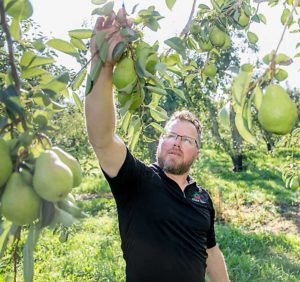—story by Matt Milkovich

Chris Gottschalk has found his bearings as the nation’s lone public pear scion breeder, and he’s ready to focus on creating pears that are easy to grow and handle and also have the flavor and texture consumers want.
Gottschalk is the apple and pear geneticist and breeder at the U.S. Department of Agriculture’s Appalachian Fruit Research Station in Kearneysville, West Virginia. When he was hired in 2021, he began sorting the program’s pear scion germplasm collection, which goes back more than a century. He’s now in the third year of a project to evaluate historical germplasm and breeding lines, funded by the Fresh and Processed Pear Research Committee.
Gottschalk identified dozens of high-value genotypes in the USDA pear collection in Corvallis, Oregon, and the Kearneysville breeding program. He found pears with sweet flavors, pears with higher acidity and pears with a wide variety of harvest timings. Now, he is evaluating the promising scions for optimal harvest date, postharvest disease resistance and supply chain handling. His collaborator on the project, USDA research plant pathologist Tami Collum, identified scions with strong resistance to blue mold and bitter rot.
The Kearneysville program was founded in the early 1900s and is the only public pear scion breeding program in the country. It had been dormant since the previous breeder, Richard Bell, retired in 2017. Its historic priority was developing fruit with resistance to fire blight, a disease known for decimating Eastern pears. Psylla resistance was another priority.
The focus on fire blight resistance has paid off, Gottschalk said, and there is now a durable presence in the program’s breeding lines. There are also some lines with strong psylla resistance, though much of that material does not have good fruit quality, he said.
Fruit quality is the program’s newest priority. Gottschalk wants to boost acidity, Brix and other flavor-affecting compounds. He also wants to focus on flesh texture. North American buyers prefer pears with melting flesh, while European and Asian markets prefer crisp flesh. He’ll focus on melting-type pears, but if he finds a crisp line it might be a good opportunity for export markets. He’s also on the lookout for rare traits such as red or pink flesh.
Another priority: minimizing postharvest disorders to improve pear packout and export potential. Other topics to address include drought and heat resistance, later bloom times and other climate-change-related traits, Gottschalk said.
Growers in the Pacific Northwest produce the vast majority of U.S. pears. Gottschalk is looking for breeding traits that will serve that market, with its greater storage, handling and transportation needs. However, he also wants to find pears that will work for smaller, direct-retail markets in other parts of the country.
Jen Baugher, president of Adams County Nursery in Pennsylvania, said more growers are getting back into pears, or trying them for the first time, due to the availability of more precocious rootstocks and blight-resistant varieties.
Fire blight and pear psylla resistance are important to the nursery’s regional pear grower customers, but so is “developing an exceptional eating experience,” she said. Most are direct marketers, and “flavor is of utmost importance to them.”
The USDA program’s most recent release, Bell (named after Richard Bell), has great flavor, aroma and fire blight resistance, but it doesn’t keep long in storage, making it a great pear for direct-market sales, Gottschalk said.
The next release might be a numbered variety with a lot of promise. US79439-004 is a late-blooming winter pear with long storage potential, an interesting flavor and good resistance to fire blight. The next step is advanced trials to better understand the scion’s harvest, storage and supply chain characteristics, he said.
Washington Tree Fruit Research Commission research horticulturist Tory Schmidt said the numbered pear is being evaluated for its performance in the Pacific Northwest. It has a juicy and unique flavor and is pleasant to eat, he said.
Schmidt, a pear grower himself, said some growers are interested in new varieties but haven’t seen a lot of “compelling options” to replace traditional cultivars such as Bosc, Bartlett and Anjou. On the other hand, established varieties are already fighting to keep their space on grocery shelves, and some people in the industry have voiced concern that new varieties might eat into sales of those standard cultivars, he said. •







Leave A Comment